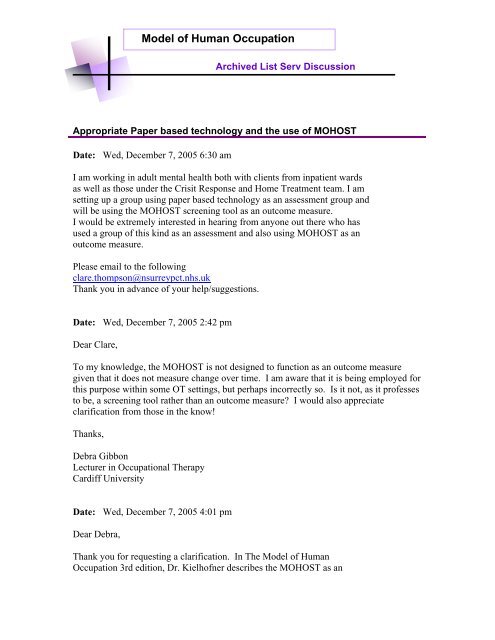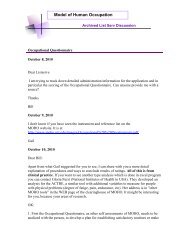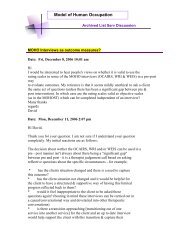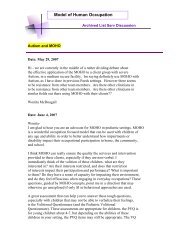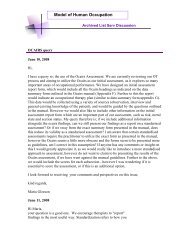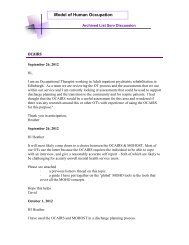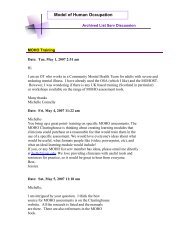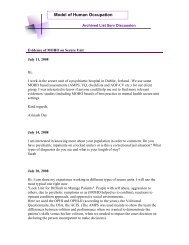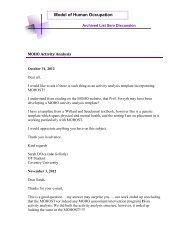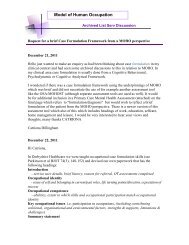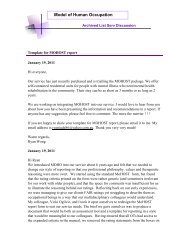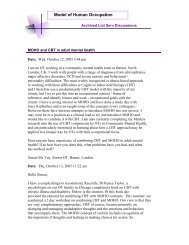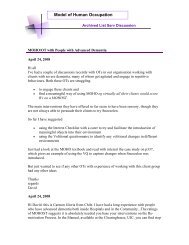Model of Human Occupation
Model of Human Occupation
Model of Human Occupation
Create successful ePaper yourself
Turn your PDF publications into a flip-book with our unique Google optimized e-Paper software.
<strong>Model</strong> <strong>of</strong> <strong>Human</strong> <strong>Occupation</strong>Archived List Serv DiscussionAppropriate Paper based technology and the use <strong>of</strong> MOHOSTDate: Wed, December 7, 2005 6:30 amI am working in adult mental health both with clients from inpatient wardsas well as those under the Crisit Response and Home Treatment team. I amsetting up a group using paper based technology as an assessment group andwill be using the MOHOST screening tool as an outcome measure.I would be extremely interested in hearing from anyone out there who hasused a group <strong>of</strong> this kind as an assessment and also using MOHOST as anoutcome measure.Please email to the followingclare.thompson@nsurreypct.nhs.ukThank you in advance <strong>of</strong> your help/suggestions.Date: Wed, December 7, 2005 2:42 pmDear Clare,To my knowledge, the MOHOST is not designed to function as an outcome measuregiven that it does not measure change over time. I am aware that it is being employed forthis purpose within some OT settings, but perhaps incorrectly so. Is it not, as it pr<strong>of</strong>essesto be, a screening tool rather than an outcome measure? I would also appreciateclarification from those in the know!Thanks,Debra GibbonLecturer in <strong>Occupation</strong>al TherapyCardiff UniversityDate: Wed, December 7, 2005 4:01 pmDear Debra,Thank you for requesting a clarification. In The <strong>Model</strong> <strong>of</strong> <strong>Human</strong><strong>Occupation</strong> 3rd edition, Dr. Kielh<strong>of</strong>ner describes the MOHOST as an
assessment that serves as a screening tool, as well as a tool tomeasure progress or change over time. A case study within the textprovides an example <strong>of</strong> the use <strong>of</strong> the MOHOST in documenting theprogress <strong>of</strong> a client.I hope this is helpful!Annie PloszajResearch AssistantMOHO ClearinghouseDate: Wed, December 7, 2005 7:02 pmThe MOHOST is so named (screening tool) because it's original use was in acontext where there needed to be a quick early assessment and since thistool <strong>of</strong>ten served as a "first screen" to identify areas for furtherassessment as well as identifying strengths and weaknesses in acomprehensive way to guide treatment planning.That said, there are many reasons why the MOHOST CAN be used as an outcomestool.Like any outcomes tool, where the aim is to show improvement due tointervention, one must administer the tool at least twice--at baseline andafter a period <strong>of</strong> intervention, in order to measure change over time. A tooladministered only at the end <strong>of</strong> therapy is really not an outcome measure,because there is nothing to compare it to in order to make inferences aboutthe outcome.When choosing an outcome tool for repeated use in clinical settings thereare two main considerations.The first is that the tool should have good psychometric properties asevidenced through research (i.e., that it is reliable, valid and sensitive).While the MOHOST is in the mid stages <strong>of</strong> development, the evidence thus farsuggests this instrument has excellent measurement properties; A first studyprovided evidence that it is reliable and valid. Another study, that we justcompleted found that each <strong>of</strong> the factors within the MOHOST (volition,habituation, motor skills, process skills, communication interaction skillsand environment, hold up as distinct factors (in a confirmatory factoranalysis) and show statistically significant differences across groups <strong>of</strong>clients. This evidence supports the value <strong>of</strong> clinical interpretations thatexamine each section <strong>of</strong> the MOHOST and it also suggests that the MOHOST candistinguish between clients with different patterns <strong>of</strong> strengths and weaknesses. Alongwith the studies mentioned above, we have also evidence <strong>of</strong>good concurrent validity.
Future research will continue to examine reliability and validity as well asfurther testing the sensitivity <strong>of</strong> the instrument in detecting change.All MOHO instruments undergoes an intensive period <strong>of</strong> psychometric testingand are revised along the way to improve measurement properties. Like otherinstruments, the MOHOST was not released until we had several stages <strong>of</strong>pilot testing and revision and an initial study <strong>of</strong> reliability and validityas well as positive feedback from practitioners about its use. .The second consideration in any outcomes instrument is that it be easy tointegrate into the program for which one wants to demonstrate outcomes. TheMOHOST has several strengths in this regard. It is highly flexible andefficient in administration which means that the demands on time for aninitial and second administration are minimized. In fact, many settings findthat it can be used to do periodic reassessment which results in "repeatedmeasures" Repeated measures data is actually some <strong>of</strong> the most valuable inoutcomes studies, since it can document a trajectory <strong>of</strong> change.Another virtue <strong>of</strong> the MOHOST for outcomes studies is that, given itsflexible means <strong>of</strong> data collection, it is easily overlapped with otherassessments and can make use <strong>of</strong> information available to the OT from ongoingknowledge <strong>of</strong> the client. For example, using the MOHOST at baseline in aphysical disabilities context where the OT must administer physicalfunctioning and ADL assessments, the information gained form theseassessments can be used to score many <strong>of</strong> the items on the MOHOST. Often avery brief interview <strong>of</strong> less than 10 minutes or other means <strong>of</strong> informationgathering that are quite efficient are sufficient to fill in whatinformation is not needed. The MOHOST can be readministered at a progresspoint or at discharge relying primarily on the information the OT hasavailable from clinical interactions with the client.All in all this efficiency in adminsitration makes the MOHOST ideal formeasuring change over time, and, thus, an ideal outcomes measure.Gary Kieh<strong>of</strong>ner


